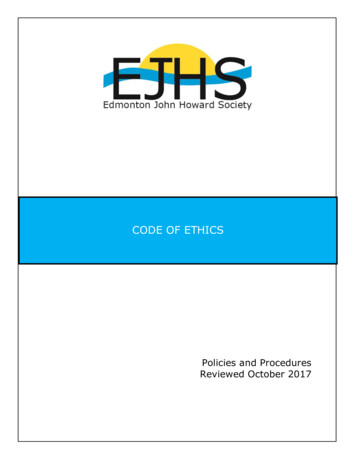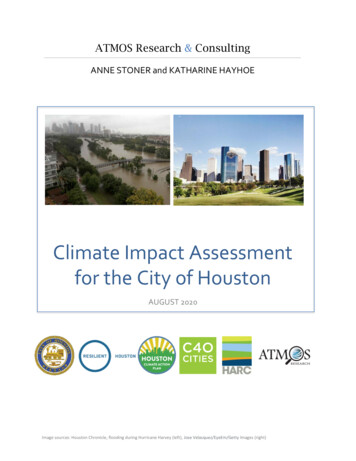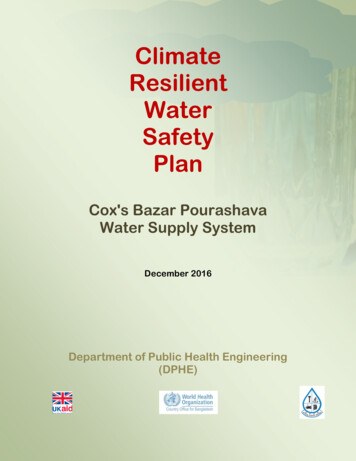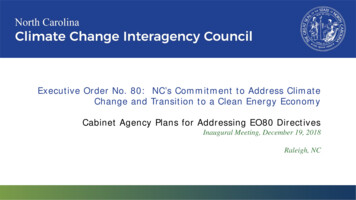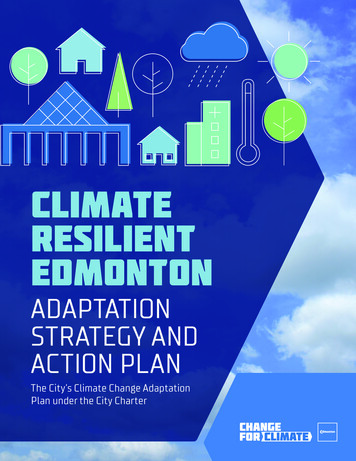
Transcription
climateresilientedmontonADAPTATIONSTRATEGY ANDACTION PLANThe City’s Climate Change AdaptationPlan under the City Charter
acknowledgementsClimate Resilient Edmonton: Adaptation Strategy and Action Plan was prepared withthe support of Edmonton’s academic, business, public institution, and governmentcommunities. The City of Edmonton is grateful for the involvement of these communities;their collective knowledge and insight was critical to understanding the specific impactsexpected in coming decades due to climate change and lay out the five priority pathstowards climate resilience. This publication is a major milestone in our journey towardscreating a more climate resilient Edmonton, but it is only the first step. As we moveahead with implementation we look forward to further collaboration with these andother impacted communities.We acknowledge the contributions from:Alberta Agricultureand ForestryBuilding Owners andManagers AssociationEdmonton Federationof Community LeaguesAlberta Association ofLandscape ArchitectsCanadian Associationof Physicians for theEnvironmentEdmonton Food BankMunicipal ClimateChange Action CentreEdmonton Food CouncilNav CanadaEdmonton InternationalAirportNorthern AlbertaInstitute of Technology(NAIT)Alberta BeverageContainer RecyclingCorporationCanadian GreenBuilding CouncilEdmonton Police ServiceAlberta ClimateChange OfficeCanadian HomebuildersAssociationAlberta Coalitionfor Chronic DiseasePreventionCanadian Pacific RailwayEnoch NationCanadian Western BankEPCORCapital PowerExplore EdmontonConcordia UniversityGreen For Life (PrivateWaste Haulers)Alberta EconomicDevelopment/InnovationAlberta Environmentand ParksAlberta Health ServicesAlberta RecyclingManagement AuthorityAlberta Serious IncidentResponse TeamAlberta TransportationAlberta Water CouncilATCO GasEdmonton Area Pipelineand Utilities OperatorsCommitteeEdmonton EconomicDevelopmentCorporationEdmonton EnvironmentalAdvisory CommitteeEdmonton Chamberof CommerceEdmonton CommunityFoundationEdmonton Public SchoolsHabitat StudiosICLEI CanadaInsurance Bureauof CanadaInternational Instituteof SustainableDevelopmentLandmark Groupof BuildersLow Impact DevelopmentPartnershipMacEwan UniversityNova ChemicalsParkland InstitutePembina InstitutePrairie Organic GrainRiver Valley AllianceRogers CommunicationsSierra Club Canada(Prairie Chapter)StantecTEC EdmontonTELUSUniversity of AlbertaUrban DevelopmentInstituteZizzo StrategyCopyright 2018 The City of Edmonton. All Rights Reserved.The preparation of Climate Resilient Edmonton: Adaptation Strategy and Action Plan was carried out with the assistance from theGovernment of Canada and the Federation of Canadian Municipalities. Notwithstanding this support, the views expressed are the personalviews of the authors, and the Federation of Canadian Municipalities and the Government of Canada accept no responsibility for them.
Table of ContentsPAGE 1INTRODUCTIONPAGE 3CHAPTER 1: CLIMATE CHANGEADAPTATION AND RESILIENCEIN THE EDMONTON CONTEXTPAGE 6CHAPTER 2: METHODSPAGE 7OVERVIEWPAGE 9EDMONTON’S SCIENCE ANDEVIDENCE BASED APPROACHPAGE 12VULNERABILITY ANDRISK ASSESSMENTPAGE 13PAGE 14PAGE 15ADAPTATION ACTION PLANNINGENGAGEMENT AND OUTREACHAPPROACHCHAPTER 3: CLIMATESCIENCE AND PROJECTIONSPAGE 21CHAPTER 4: IMPACTSAND OPPORTUNITIESPAGE 22PAGE 23HUMAN HEALTH AND SOCIALWELFARE CONSEQUENCESECONOMIC CONSEQUENCESPAGE 23 URBAN INFRASTRUCTURECONSEQUENCESPAGE 24 ENVIRONMENTCONSEQUENCESPAGE 24PAGE 25OPPORTUNITIESCHAPTER 5: PATH TO A CLIMATERESILIENT EDMONTONPAGE 33IMPLEMENTATIONAND MONITORINGPAGE 34 CONCLUSIONPAGE 17CHANGING TEMPERATURESPAGE 35GLOSSARYPAGE 18CHANGING PRECIPITATIONPAGE 36REFERENCESCHANGING WEATHERPAGE 37 APPENDIX A: TABLE 8.ADAPTATIONACTION PLANIMPLEMENTATION TABLEPAGE 19EXTREMESPAGE 20CHANGING ECOSYSTEMSPAGE 39APPENDIX B: TABLE 9. CLIMATEVARIABLES ASSESSEDAll technical information contained within this report is provided for information purposes only and is not intended to be used for any otherpurposes. The City of Edmonton is not responsible for any unauthorized or inappropriate use of the information contained within this report.
forewordWe commit to and call upon all national, state and local governments to undertakeclimate risk and vulnerability assessments to guide their planning and investmentdecisions, increase climate resilience and minimize the exposure of people and assets tothe impacts of climate change. EXCERPT FROM THE EDMONTON DECLARATION, 2018Cities around the world are working swiftly to develop andimplement plans in response to climate change. Edmonton hasworked judiciously to ensure that city operations and the widercommunity have a well-researched, scientifically sound andstakeholder-validated strategy and action plan to follow. Ashost of the inaugural IPCC Cities and Climate Change ScienceConference in March 2018, Edmonton had the distinct pleasure ofinteracting with scientists from around the world who emphasizedthe need for urgent action on reducing greenhouse gas (GHG)emissions to lessen the most extreme consequences of climatechange. Edmonton’s plan for reducing GHGs is being implemented,but there remains a need to prepare our city for the repercussionsof a warming planet. The Edmonton Declaration that resulted fromthe conference was a call to the global scientific community toadvance its efforts in support of evidence-based climate actionin cities, enabling ambitious climate action plans.I have said this before, and it bears repeating, that the city needsthe participation of scientists, researchers, business, civil society,artists and students — a whole village — to tackle the challengesof climate adaptation and resilience. Climate Resilient Edmonton:Adaptation Strategy and Action Plan illustrates not only thegravity and urgency of climate change and the impacts for whichEdmonton must prepare itself, but a well-considered plan fortaking on this challenge — a plan that involves the “whole village.”To leave this work to others is irresponsible and would putEdmonton in a vulnerable and unsustainable position. Aroundthe world, people are calling on their leaders to transition theircities to low-carbon living and, at the same time, to adapt to achanging climate and move ourselves toward resilience. ClimateResilient Edmonton is a science and evidence-based plan that putsEdmonton on this path.Mayor Don Ivesondon ivesonmayor
CLIMATE RESILIENT EDMONTON ADAPTATION STRATEGY AND ACTION PLANMessage from the City ofEdmonton’s EnvironmentalAdvisory CommitteeThe City of Edmonton is pleased to be supported by a volunteer committee of citizensthat provides Administration with strategic advice on environmental programs andtopics. For over 22 years, the City’s Environmental Advisory Committee (EAC) hasprovided a critical public perspective on environmental issues, and the currentmembership is no exception, demonstrating its commitment to improving the City’senvironmental performance.Membership on the Committee is comprised of ninecitizens-at-large and one representative from eachof Alberta Health Services, Alberta Environment andParks, MacEwan University and Concordia Universityof Edmonton. The EAC was actively involved in theevolution of Climate Resilient Edmonton: AdaptationStrategy and Action Plan by asking probing questions,providing guidance over the course of its development,responding to discussion papers and advising onpublic communications. Following is the Committee’sresponse to Climate Resilient Edmonton.The Environmental Advisory Committee (EAC)endorses this strategy and action plan based on: theprocess employed to develop the plan, the range ofstakeholders consulted, efforts to raise awarenessamong the public, membership and oversight of theClimate Resilient Edmonton Strategy StakeholderCommittee, the diligence shown by the projectworking team and, perhaps most importantly, theEAC recognizes the significant and serious nature ofthis work. Leaders at the City of Edmonton are beingproactive with this strategic approach to climatechange, creating momentum across the region. Thisplan will help to provide citizens with a sense of securitythat leadership is committed to addressing futurechanges in climate, even in times of uncertainty.Climate Resilient Edmonton: Adaptation Strategy andAction Plan is the first climate change resilience plan forEdmonton. Due to the complex nature of this strategy,it was developed primarily with input from the scientificand expert community. However, since June 2016 whenthe plan was in very early stages of being formulated,the City has engaged the EAC with progress updatesand sought feedback on ongoing and upcoming work.
Message from the City of Edmonton’s Environmental Advisory Committee (continued)The EAC points out the following considerations fromthe Action Plan, each of which requires adequatefunding to enable successful implementation: Ongoing climate resilience research: Giventhat actions for resilience are relatively new formunicipalities around the world, there will be aneed for all pieces of the implementation plan to bereflective of scientifically-sound understanding.This includes the monitoring and incorporationof new practices and learning from othermunicipalities, and the most current developmentsin research. The integration of new information willenable evidence-based decision-making, and allowfor this initial strategy to be revised over time. Climate resilience of infrastructure and greenspaces: Infrastructure, in all its forms, mustbe newly developed or retrofitted to meet anew climate future. From placement of utilityinfrastructure, to (permeable) materials for hardsurfaces, integration of public cooling stationsand potable water, design of bridges and buildings,policies that advance climate-proofing in newneighbourhoods, vegetation choices for greenspaces and parkland, and so on—all forms ofinfrastructure need to be thoughtfully and skillfullydesigned now for a new climate reality. Climate resilience of people: citizens will need to beprepared in advance for climate shocks and developskills for adapting their spaces and lifestyles for achanging climate. This in-depth engagement willobviously include emergency preparedness, butmust also build capacity that will activate citizens,neighbourhoods and communities to becomingclimate resilient.The EAC is pleased that the City has taken on thiswork and supports the City’s commitment toadapting its operations for resilience in the greatercommunity. Preparedness for the potential impactsof climate change is the best way forward. The Citymust move forward with research, policy changesand support for citizens and stakeholders to ensurethat Edmonton will thrive and be a leader in a newclimate future. This strategy and action plan is acommendable first step to a resilient Edmonton.
CLIMATE RESILIENT EDMONTON ADAPTATION STRATEGY AND ACTION PLANintroductionOur climate is already changing, both globally and locally. It’s affecting ourweather, environment, economy and health. Unless significant global efforts toreduce greenhouse gas (GHG) emissions occur, climate change will have seriousand continued impacts on Edmonton.more variable extreme weather events, and anoverall warmer and drier climate (see Chapter 3).Without action, these impacts can exacerbateexisting climate pressures on our economic, social,infrastructure, and environmental systems.The good news is that we can position ourselvesto be better able to withstand and adapt to thesechanges. We can create and follow a pathway thatwill help us manage the risks of climate change. Wecan increase our knowledge, adjust our lifestyles andadapt to changes that have already taken place. Thisdocument—Climate Resilient Edmonton: AdaptationStrategy and Action Plan—will help set Edmonton onthis path so that we can be prepared for and respondto anticipated climate change impacts.While climate change efforts are underway at bothnational and provincial levels, cities are often leadersin climate change mitigation and adaptation initiatives.Edmonton is one of those cities. The City of Edmontonis already in the process of implementing ourCommunity Energy Transition Strategy, which aimsto reduce greenhouse gas emissions in Edmonton.Our Climate Resilient Edmonton: Adaptation Strategyand Action Plan is complementary to those efforts.It’s also part of City Council’s Initiative on EnergyTransition and Climate Resilience and the City ofEdmonton’s overall leadership on climate changeissues. The plan focuses on understanding how theclimate impacts we are already experiencing mayshift in the future due to ongoing climate change.It looks at what this means for our community andprovides insight into how we can build resilience forthose impacts.There is international recognition that climate changeis an urgent threat and that global pursuits are neededto reduce GHG emissions and limit global warming.Ninety-seven percent of actively publishing climatescientists agree that the world is experiencing achange in climate caused by humans (Cook et al.2016). Historical climate records also show the worldis warming at unprecedented rates. These climaterecords indicate that Edmonton is warming at a fasterrate than the global average. Scientists predict thatEdmonton will be exposed to higher temperatures,drier summers, more extreme precipitation events,How will Edmonton adapt to these effects of climatechange? We need to work towards becoming aclimate resilient city—a city in which our institutions,communities, businesses, and individuals have thecapacity to function, survive, adapt and thrive inresponse to any sudden and short disruption theymay experience. This plan will guide us, through itspaths, goals, strategies and actions.In 2016, we began an investigation to understandhow Edmonton’s climate has already changed andhow it might change in the future. We conducted anEdmonton-specific climate risk and vulnerabilityassessment. We also determined the potential risksand opportunities these changes could presentfor our communities. Climate Resilient Edmonton:Adaptation Strategy and Action Plan is the result ofthis work. With its foundation in science and evidence,it sets a pathway towards climate resilience. It’s ourway towards a bright future as we face the effects ofclimate change.As part of our research and knowledge gathering, wespoke with Edmontonians. They told us that they’reworried about the changing climate—a 2018 poll ofresidents indicates that 73% are concerned aboutclimate change and 72% think that we need to actnow to respond to climate change. Our residents arecritical to helping us become more adaptable andresilient, which is why we included their opinions informing a vision for our strategy.We also consulted with other stakeholders andsubject matter experts to develop this plan. Theknowledge these experts shared with us formed animportant part of our learning and evidence gatheringprocess.PAGE 1
In 2018, Edmonton hosted the first everIntergovernmental Panel on Climate Change’s (IPCC)Cities and Climate Change Science Conference. Theevent established a global research agenda focusedon the science of cities and climate change. Thisongoing research and knowledge sharing betweenworld-wide cities will help inform future versions ofthis document.The Change for Climate Global Mayors Summit washeld alongside the conference. There, the EdmontonDeclaration was developed. It recognizes the expertconsensus that cities, towns and regions must play acentral role in adapting to and mitigating the effects ofclimate change to reduce GHG emissions, given thatmore than half of the world’s population live in urbanareas and produce more than 70% of energy-relatedGHG emissions. The Edmonton Declaration calls uponcities to take bold action on climate change. To date,over 3,000 cities have endorsed the declaration. Thisstrategy delivers on adaptation commitments fromthe Edmonton Declaration.Climate Resilient Edmonton: Adaptation Strategy andAction Plan is Edmonton’s Climate Change AdaptationPlan under section 615.5 of the City Charter. Thestrategy outlines how the City of Edmonton will planand invest resources to increase our communities’climate resilience, minimize the exposure of peopleand assets to the impacts of climate change, andtake advantage of new opportunities as they arise.It begins with an examination of climate changeadaptation and leads into an outline of the methodsEdmonton used for its adaptation planning. Anoverview of Edmonton-specific climate changescience and a brief discussion on the primary impactsthat predicted climate changes will have on Edmontonfollows. It’s capped with a synopsis of the adaptationactions needed to respond to those impacts.This document represents the first iteration ofEdmonton’s climate change adaptation journey. Itwill be a living document, to be revisited and updatedas new information becomes available and asadaptation planning and actions evolve. We inviteevery Edmontonian to join us on the path towardsEdmonton’s climate change adaptation and resilience.Qualities of a Resilient City(100 Resilient Cities)REFLECTIVE:FLEXIBLE:INCLUSIVE:People and institutions reflectand learn from past experiencesand leverage this learning toinform decision making.Refers to the willingness andability to adopt alternativestrategies in response tochanging circumstancesor sudden crises. This canbe achieved through newknowledge and technologies.Inclusive processes emphasizethe need for broad consultationand many views to create asense of shared ownershipof a joint vision to build cityresilience.RESOURCEFULNESS:Integrated processes bringtogether and align city systemsto promote consistencyin decision making andinvestments. Exchangeof information betweencomponents of the systemenables them to functioncollaboratively and respondrapidly.ROBUSTNESS:Urban physical assets aredesigned, constructed andmaintained in anticipation ofhigh-impact climate events.REDUNDANCY:Spare capacity is built intothe system to account fordisruptions and surges indemand. It also involvesmultiple ways of fulfillinga need or function.Citizens and institutions areaware of climate risks, able toadapt to shocks and stressesand can quickly respond to achanging environment.PAGE 2INTEGRATED:
CLIMATE RESILIENT EDMONTON ADAPTATION STRATEGY AND ACTION PLAN1climate changeadaptation andresilience inthe edmontoncontextPAGE 3
1CLIMATE CHANGE ADAPTATION AND RESILIENCE IN THE EDMONTON CONTEXTClimate Change Adaptationand Resilience in theEdmonton ContextThe Earth’s climate is changing. While it has changed throughout the history of theplanet, the current rate of change is unprecedented (IPCC Fifth Assessment Report,Summary for Policymakers 2014). The earth’s temperature has risen approximately1.1 degrees Celsius ( C) since the late 1800s (NASA 2018). Most of the warming hasoccurred in the past 35 years. This warming trend is projected to continue throughoutthe next century onwards. The effects of global climate change can be seen in thewarming and acidification of oceans in addition to sea level rise; shrinking of icesheets and glacial retreat; decreased snow cover; and changes in the frequencyand intensity of extreme events (NASA 2018).Organizations and governments worldwide can take“mitigation” and “adaptation” actions in response toclimate change. Mitigation refers to actions taken toaddress the causes of climate change, namely actionsto reduce the concentration of greenhouse gases inthe atmosphere. Adaptation refers to actions taken toaddress the impacts of climate change and to respondto the local risks and opportunities climate changemay bring. The City of Edmonton’s CommunityEnergy Transition Strategy, passed unanimouslyby City Council and currently being implemented, isthe path forward for Edmonton to mitigate climatechange and reduce greenhouse gas emissionsproduced by our community. Climate ResilientEdmonton: Adaptation Strategy and Action Plan, setsa path to respond to the impacts Edmonton will facefrom a changing climate.typically have many of the planning and policy toolsavailable to address climate change impacts such asland use planning and zoning, design guidelines forinfrastructure and development, and emergencymanagement.While this adaptation strategy and action planfocuses on impacts to Edmonton, the City ofEdmonton recognizes that global climate changescould have specific impacts on Edmonton. Forexample these changes could impact the global foodsystem and increase climate migration. Determiningwhat these impacts might be will require furtherdetailed studies than what was conducted to informthis strategy. This strategy focuses on local impacts,but it will be important going forward to monitorglobal trends and gain a better understanding ofwhat global impacts will mean for Edmonton.While climate change is a global issue, impacts arebeing felt at a local scale and will differ depending onthe local context. To be successful climate changeadaptation efforts must be taken at a local scale,including government action. Local governmentsPAGE 4
CLIMATE RESILIENT EDMONTON ADAPTATION STRATEGY AND ACTION PLANMITIGATION AND ADAPTATION DIAGRAMGREENHOUSE GAS EMISSIONSCAUSE CLIMATE CHANGEMITIGATIONaction to reduceemissions thatcause climatechangeEnergy Transition Strategy and CivicOperations Greenhouse Gas ManagementPlanADAPTATIONaction to managethe risks ofclimate changeimpactsCLIMATE CHANGEIMPACTS EDMONTONClimate Resilient Edmonton:Adaptation Strategy and Action PlanPAGE 5
2METHODS2methodsPAGE 6
CLIMATE RESILIENT EDMONTON ADAPTATION STRATEGY AND ACTION PLANmethods: OverviewClimate change adaptation planning is complex, and requires analysis of climatescience and research as well as expertise in analyzing climate change impacts. The Cityof Edmonton has followed adaptation planning best practices including methodologyand commitments from the International Council for Local Environmental Initiatives(ICLEI) Canada’s Building Adaptive and Resilient Communities program and the GlobalCovenant of Mayors for Climate and Energy. Edmonton has taken a broad approachin developing a climate change adaptation strategy for the community, including bothCity-owned and community assets and services. Table 1 identifies the asset and servicearea themes and descriptions included in this strategy development.TABLE 1. ASSET AND SERVICE AREA THEMES AND DEFINITIONSAsset and ServiceArea ThemeAsset and Service Area DescriptionPeopleHealth and Safety: The physical and mental health of Edmontonians, includingmortality (premature death) and morbidity (injuries, illnesses/disease, stressand anxiety) outcomes.Community and Culture: Heritage, cultural, amenity (including recreation) andplace-making (including access to food, education, transport, medical services)aspects of the community that affect the well-being or quality of life ofresidents.Emergency Management: The organization and management of resourcesand roles for dealing with all aspects of emergencies including preparedness,response and recovery (e.g. fire, ambulance, police, etc.).FoodThe growing of food and raising of animals for food and other uses within andaround the city, including related activities such as the production and deliveryof inputs and the processing and marketing of products, where relevant.WaterStormwater: The stormwater management system, including roads andsidewalks, stormwater pipes and natural drainage areas.Drinking Water: the withdrawal and treatment of raw water, and the supply ofpotable water to industrial, commercial and residential end-users.Wastewater: The collection, treatment and disposal of wastewater.PAGE 7
2METHODSInfrastructureBuildings and Property: Commercial, residential, industrial and public buildings(schools, hospitals, recreation facilities, etc.), as well as land and property.Waste Management: The collection, treatment and disposal of solid waste,including recycling facilities and landfills.Roads: The road network (including highways and bridges).Rail: The light rail transit (LRT) network.Air: Edmonton International Airport.Active Transportation: Biking and walking trails and infrastructure.Information and Communications Technology: Information and communicationsinfrastructure, including telephone lines, cable, fibre-optics and relatedinfrastructure.Electricity: The electricity system, including transmission lines, substationsand distribution lines.Fuel Supply: Infrastructure to support the supply of light and heavy fuel oils.PlacesNatural Environment: Natural areas such as the urban forest in the river valley,manicured parks, trees, terrestrial habitats and ecosystems, aquatic habitatsand ecosystems, air quality and soil quality.Built Environment: The planning and design of the city.EconomySmall, medium and large enterprises in both goods producing (e.g., construction,manufacturing) and service producing (e.g., finance, banking, insurance and realestate, wholesale and retail trade, tourism, etc.) sectors of the local economy.PAGE 8
CLIMATE RESILIENT EDMONTON ADAPTATION STRATEGY AND ACTION PLANPHASE 1PHASE 2PHASE ’s Science and Evidence Based Approach Engaging various local and regional stakeholdersand subject matter experts at more than tenDue to the important and complex nature ofthis work, community stakeholder and partnerperspectives were needed to steer this work.The City of Edmonton partnered with communitystakeholders in the development of Climate ResilientEdmonton: Adaptation Strategy and Action Plan,using a multi-stakeholder approach to climatechange adaptation planning. This included: A strategy stakeholder committee made up ofsubject matter experts who represented thestrategy’s asset and service areas themes. Thecommittee was formed at the beginning of thiswork and met throughout the planning process toprovide input, analysis and subject matter advice onall aspects of the work.workshops to assess the levels of risks andvulnerabilities that climate change may have onidentified asset and service areas. Conducting an economic analysis to provide anunderstanding of an overall measure of economiccost of climate change to Edmonton, in the absenceof additional planned adaptation. Hosting a workshop to identify potential economicopportunities that may arise for Edmonton becauseof climate change. Learning from the first ever IPCC Cities and ClimateChange Science conference. Over 50 organizations participated by sharingtheir knowledge and expertise in assessing climatechange risks and opportunities. Partnering with the City of Calgary to commissiona series of papers to understand the qualities ofclimate resilient cities.Edmonton’s adaptation strategy development can begrouped into three phases: investigation, directionsetting and taking action. Conducting climate change adaptation andresilience case studies.INVESTIGATION PHASEThis phase involved identifying pathways to a climateresilient Edmonton. It was informed by the knowledgegained and evidence gathered in the investigationphase, as well as through direction from other keyguiding work, including:This phase involved research and analysis, including: Conducting a current state assessment ofEdmonton’s level of risk to current climateconditions using the C40 Cities Climate LeadershipGroup’s climate hazard taxonomy. Understanding how Edmonton’s climate haschanged over the past 100 years. Developing future climate change projections andscenarios (see Chapter 3). Assessing Edmonton’s climate change risks andvulnerabilities (see Chapter 4).DIRECTION SETTING PHASE The City of Edmonton Charter Regulation whichrequires the City to establish, review and updatea plan for adapting to the effects of climatechange. The climate change adaptation plan mustbe based on an assessment of the exposure, riskand vulnerability of systems within Edmonton toeffects of climate change over the short, mediumand long term.PAGE 9
2METHODS The Edmonton Declaration, which commits localgovernments (from an adaptation perspective) to:reviewed and updated at least every five years,to ensure that the best available science andevidence is being used in adaptation planning.Ongoing measurement and reporting of Edmonton’svulnerabilities is required to assess the success ofadaptation actions and to determine any changesto vulnerabilities. A monitoring plan and evaluationprocess that reviews the implementation andprogress of Climate Resilient Edmonton: AdaptationStrategy and Action Plan will be developed.» Undertake climate risk and vulnerabilityassessments to guide their planning andinvestment decision, increase climate resilienceand minimize the exposure of people and assetsto the impacts of climate change.» Establish formal, science-based policy anddecision-making processes within theirorganizations. Edmonton’s 2050 Vision and Council’s StrategicPlan (2019-2028), which contains the climateresilient goal:» Edmonton is a city transitioning to a low-carbonfuture, has clean air and water and is adapting to achanging climate. Public input to further define a vision for a climateresilient Edmonton.City staff and key collaborators were consulted todevelop the action plan and the strategy stakeholdergroup was engaged to evaluate identified actions. Themain output of this phase of work is this document.TAKING ACTION PHASEThis phase will be the ongoing implementation ofthe work to date. To be successful, implementationwill require engagement with residents andimplementation partners. The strategy will beAs part of the science and evidence based approach,several climate variables and associated impactswere considered in the assessment. Two types ofclimate related impacts were included in Edmonton’sassessment: sudden onset and slow onset. Suddenonset are discrete, short term events that typicallylast minutes, hours, or days (UNFCCC 2012). Theseevents already occur, however climate change isaltering their frequency, intensi
plan will help to provide citizens with a sense of security that leadership is committed to addressing future changes in climate, even in times of uncertainty. Climate Resilient Edmonton: Adaptation Strategy and Action Plan is the first climate change resilience plan for Edmonton. Due to the complex nature of this strategy,


